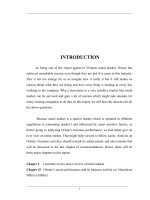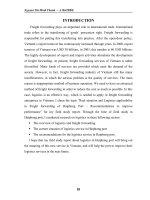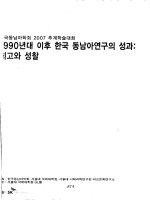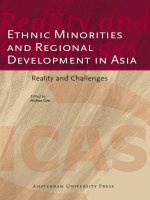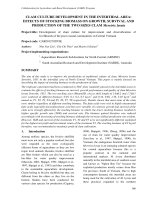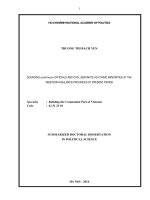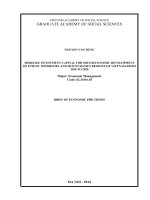Consanguineous marriage in Ethnic minorities area - situation and issues
Bạn đang xem bản rút gọn của tài liệu. Xem và tải ngay bản đầy đủ của tài liệu tại đây (1.24 MB, 6 trang )
CHIẾN LƯỢC VÀ CHÍNH SÁCH DÂN TỘC
CONSANGUINEOUS MARRIAGE
IN ETHNIC MINORITIES AREA - SITUATION AND ISSUES
Vu Thi Thanh Minh
Vietnam Academy for Ethnic Minorities
Email:
Received: 15/9/2019
Reviewed: 5/10/2019
Revised: 15/10/2019
Accepted: 9/11/2019
Released: 20/11/2019
DOI:
C
onsanguineous marriage has left many consequences
for many families and society, which directly affecting
the next generation of the married people. Consanguineous
marriage has seriously affected the mothers and children’s health,
reducing the quality of the lineage, the quality of population and
human resources of ethnic minorities erea. Now, consanguineous
marriage has been taking place in ethnic minorities area of our
country, especially in remote and isolated areas bordering the
Northern Midland and mountainous provinces, North Central and
Central Coast areas, Central Highlands.
The consequences of consanguineous marriage for the family
and society aren't small requiring us to have appropriate and
practical solutions and policies to minimize this situation.
Keywords: Consanguineous marriage; Ethnic women and
children; Consequences of consanguineous marriage.
1. Introduction
Consanguineous marriage is a marriage
between a male and a female of the same direct
blood line, between relatives within the range of
three generations1. This is a ban imposed by the
laws of the Socialist Republic of Vietnam in the
Law on Marriage and Family in 2000 and 2014.
Consanguineous marriage has seriously affected the
mothers and children’s health, reducing the quality
of the lineage and the quality of the population
of ethnic minorities erea. Children are born from
consanguineous married couples which have a
higher incidence rate of birth defects, growth
retardation, malnutrition and neonatal mortality
than other normal children. Vietnam is classified as
a high-risk area with over 5 million people carrying
the congenital hemolytic gene, more than 20,000
patients to be needed treatment and about 2,000
babies were born ill each year. Because children
born to consanguineous couple are susceptible to
illness, so there is no opportunity to work, leading
to difficult life, the risk of a broken marriage. Many
female children do not have the opportunity to
be a mother because of their weak body, disease
and inadequate development. Consanguineous
marriage limited female children’s educational
opportunities, depriving them of opportunities
for training and stable employment. Women who
have consanguineous marriages often have birth
. Clause 12, 13,Rule 8, Law on Marriage and Family in
2000; Clause 17,Rule 3,Marriage and Family in 2014;
1
18
defects, which has a significant impact on their
mental and physical development. Especially the
child mortality and morbidity rate of this group
is very high. This fact has seriously affected the
quality of human resources in ethnic minority and
mountainous areas.
2. Research overview
Consanguineous marriage situation occurs often
in ethnic minority areas and in many ethnic minority
communities in our country and this problem
has been paid much attention, studied by many
scientists for many years, and there were seminars
at all levels with many presentations of scientists
to discuss this issue. The most prominent research
work is Child marriage and consanguineous
marriage in ethnic minorities in Quang Binh
province by Assoc. Prof. Dr. Nguyen Van Manh
(Journal of Science and Technology of Quang Binh
Province - No. 2/2017). This research work analyzed
the situation of child and have consanguineous
marriage of ethnic groups such as Ta Oi, Bru - Van
Kieu, Chut in Quang Binh province and evaluated
the consequences of the above phenomenon. The
master‘s thesis by Le Xuan Can, Consanguineous
marriage control in accordance with Vietnamese
law - Hanoi National University, 2017 analyzed
the current situation of the law on controlling have
consanguineous marriage in Vietnam, at the same
time, it also mentioned the practice of applying the
law of controlling have consanguineous marriage
and proposing some solutions to improve the
JOURNAL OF ETHNIC MINORITIES RESEARCH
CHIẾN LƯỢC VÀ CHÍNH SÁCH DÂN TỘC
effectiveness of the implementation and application
of the law of controlling the have consanguineous
marriage in Vietnam... In 2014, the Prime Minister
approved the Scheme “Minimize child marriage and
have consanguineous marriage in ethnic minority
areas during 2015-2025”. Since then, on the portal
of ministries, agencies, of provinces with many
ethnic minorities living, there are articles about
have consanguineous marriage for ethnic minorities
or have consanguineous marriage in each ethnic
minority group specifically.
3. Research method
In this research, the author mainly uses the
materials source through ethnographic and
sociological fieldwork; at the same time analyzing,
synthesizing and using earlier research works of
previous scientists and from reports, presentations
at national and international conferences of the
Committee for Ethnic Minorities; Ministry of
Education and Training; reports on monitoring
and evaluation of ethnic policies of the National
Assembly Ethnic Council; General Statistics Office...
4. Research results
Over the past years, the Party and the State have
made many guidelines, policies for investment
in socio-economic development in mountainous
areas, taking care of material and spiritual life
for ethnic minority people. Along with the strong
socio-economic development, all levels, branches
and localities have simultaneously implemented
many measures to enhance the State management,
promote propaganda in association with movement
of ethnic minorities to reduce backward customs
and practices, especially to reduce child marriage
and consanguineous marriage.
The Committee for Ethnic Minorities has
developed and submitted to the Prime Minister to
issue Decision No. 498/QĐ-TTg dated April 14th,
2015 for approval of the Scheme “Minimizing child
and consanguineous marriage in ethnic minority
areas during the 2015-2025 period”. The goal is to
reduce the average by 2% to 3%/year of the number
of child marriage couples and from 3 to 5%/year
of the number of consanguineous couples to ethnic
minorities erea with a high rate of consanguineous
marriage. By 2025, basically restricting child and
consanguineous marriage in ethnic minority areas.
One of the solutions is to develop an intervention
model for some ethnic minorities in the Northern
mountainous region, the Central Coast, the Central
Highlands, where there is a high rate of child and
consanguineous marriage. In 2016, the Committee
for Ethnic Minorities selected 15 provinces with
high rate of child and consanguineous marriage to
build a pilot model. Through the activities of the
Project, officials are working in ethnic minority areas
and ethnic minorities have been disseminated more
widely on the Law on Marriage and Family, the
Law on Gender Equality, the Law on Prevention and
Volume 8, Issue 4
Control of Domestic Violence. Many localities have
directed the criteria of saying no to child marriage,
consanguineous marriage to the family and village
conventions; integrating communication activities
on prevention and combat of child marriage into the
implementation of policies on reproductive health
care and family planning, actively contributing to
building cultural life, improving the quality of the
population in ethnic minorities ereas. Awareness
level of ethnic minorities is gradually improved;
good traditional culture is preserved and developed;
basic backward customs and practices are repelled.
Some backward customs and practices directly affect
child and consanguineous marriages are gradually
abolished, in some communes, consanguineous
marriage does not occur. In addition to the results,
up to now, consanguineous marriage is still very
difficult, and complicated social problem that needs
to be focused on solving.
At present, consanguineous marriage has
reduced but still has the potential to break out again
in some ethnic minorities in ethnic minorities erea,
most commonly married between brother’s and
sister’s children.The results of the socio-economic
development survey of 53 ethnic minorities in 2015
showed that the rate of consanguineous marriage
of 53 ethnic minorities was 0.65%, of which ethnic
minorities had a high rate of consanguineous
marriage including: Ma 4.41%, Mang 4.36%.
Mnong 4.02%, Xtieng 3.67%,… consanguineous
marriage occurs mainly in the Northern Uplands
and the Central Highlands. Some ethnic groups
such as Lo Lo, Ha Nhi, Phu La, Chut, E De, Chu
Ru, Si La, Pu Peo, Mong, Ro Mam, Brau ... have
quite high rate of consanguineous marriage, up to
10%, that is for every 100 marriage cases, there
are 10 cases of consanguineous marriage (General
Statistics Department and Committee for the
Ethnic Minorities, Survey on socio-economic status
of 53 ethnic minorities, 2015). In the Northern
Mountainous region and Central Highlands, the
most common is the marriage of brother’s and
sister’s children, that is marriages between children
of an older brother or a younger brother and the
children of an older sister or younger sister.
According to the General Department of
Population, Planning and Family, in some ethnic
groups such as Lo Lo, Ha Nhi, Phu La, Chut, E De,
Chu Ru, Chut ... and especially the Si La ethnic
groups (Dien Bien province, Lai Chau province), Lo
Lo, Pu Peo (Ha Giang province), Mong Xanh (Lao
Cai province), Ro Man, Brau (Kon Tum province),
there are about 10 cases out of 100 consanguineous
marriage. They are ethnic minorities that are most at
risk of declining in population quantity and quality,
most likely due to the situation of consanguineous
marriage. The Brau and Ro Mam people have many
birth defects, many diseases, poor health status and
high rate of child mortality. Most of them have never
heard of the Law on Marriage and Family. Many
19
CHIẾN LƯỢC VÀ CHÍNH SÁCH DÂN TỘC
people get married without marriage registration.
Or when coming to the People’s Committee of the
commune to register the procedure for marriage,
they only fill out the form according to the printed
form, each person has a different surname, so
the commune authorities can not know whether
they are close relatives. In 2012, the General
Department of Population and Family Planning
conducted a survey of consanguineous marriage in
44 communes of 9 districts in Lao Cai province and
detected 224 consanguineous couples, of which 221
couples were uncle’s children and aunt’s children
to marry each other; the sister’s children married
the younger brother’s children, the nephew got
married with her uncle are rare cases. The above
survey also revealed that some alarming results in
practice: These 224 pairs gave birth to 558 children,
of which 51 children were abnormal. From birth,
they had diseases such as albino, mental retardation,
paralysis, dumb, white eyelashes, blindness...
and 8 children died prematurely. According to
the statistics of the Ethnic Committee of Lao Cai
province, from 2015 to the end of June 2017, 30
people (15 couples) were consanguineous couples,
an average of 6 pairs/year; comparing with the
2009 – 2013 period, the number of consanguineous
couples decreased by 3.2 times.
Particularly in Ha Giang province, in 11/11
districts and cities with a total of 476/ 2,048 villages
of 115/195 communes, wards and towns are in the
situation of consanguineous marriage. In Meo Vac
town, 8 out of 50 households are consanguineous
couples. In Moc Chau district, Son La province, in
2013 the number of consanguineous marriage was 7
couples... In Kon Tum province, through a survey of
the Department of Population and Family Planning
in 2012 in 6 communes of 3 dictricts including Sa
Thay, Ngoc Hoi and Kon Plong have detected 56
pairs of consanguineous marriages/total 350 pairs
of child marriage (accounting for nearly 1/6 of child
marriage); especially, the consanguineous marriage
situation is quite common among young people
of Chut ethnic group in Rao Tre village (total of
35 households with 137 people and 100% is Chut
ethnic group), Huong Lien commune, Huong Khe
district, Ha Tinh province. According to Cao Bang
province’s Department of Population and Family
Planning, Cao Bang province’s consanguineous
marriage takes place most often among the Dao
and Mong ethnic groups, even with the Tay ethnic
group (The Prime Minister, 2015).
There are many causes for consanguineous
marriage among ethnic minorities, including the
following basic causes:
Objectively, due to the influence of traditional
concepts, backward customs and practices, the
people still do not fully understand the harm and
the consequences of child marriage. At the same
time, due to difficult natural conditions, topography
20
of the mountainous provinces, ethnic minorities
area are divided, the climate is harsh; infrastructure
lack of synchronization, difficult transportation,
low population density, uneven distribution have
affected the people’s reception of information, and
the improving of people’s intellectual standards.
In particular, due to difficult economic
conditions, underdevelopment has significantly
affected the perception and behavior of the people.
Although, ethnic minority areas have achieved
great results in poverty reduction and hunger
elimination, but so far, poverty has been imbued
with ethnic minorities, especially people in remote
and isolated areas, “by the end of 2017, there
were nearly 865 thousand of poor ethnic minority
households, accounting for 52.66% of the total
poor households in the country.The gap between
rich and poor among regions and population
groups has not been narrowed, especially in the
Northern mountainous region and the Central
Highlands. The average income of ethnic minority
households is only 2/5 of the average income of the
whole country”(Committee for Ethnic Minorities
& Embassy of Ireland, 2019) has made health
care and investment for children’ learning of
ethnic minorities to become more difficult. When
ethnic minorities, especially in remote areas, are
increasingly concerned about hunger and poverty,
it is difficult to pay attention to other issues. Along
with that are the shortcomings and limitations in
the provisions of the Marriage and Family Law, the
relevant legal provisions and the impact, impact of
the negative aspects of the market mechanism.
Subjectively, due to the limited intellectual
level and legal awareness of the people, it is not
yet understood that consanguineous marriage is a
violation of the law. Education and training in ethnic
minority and mountainous areas is still limited. By
2015, an average of only 79.2% of ethnic minorities
could read and write in Vietnamese.The rate of
trained ethnic minority laborers is still very low, only
6.2% of employed ethnic minority laborers have been
trained, equal to one third of the average rate of the
labor force of the whole country, the majority of ethnic
minority workers are only trained to intermediate
levels (Bich Nguyen, 2018). Human resources in
ethnic minority areas have only reached 2.8% for
undergraduate and postgraduate, particularly 1.1%
for ethnic minorities, 4 times lower than that of the
whole country. The qualification of the contingent of
leaders and managers in ethnic minority areas is still
low, failing to meet the requirements of local socioeconomic development. Out of 48,200 commune
ethnic minority officials, the number of people with
lower secondary education accounting for 45.7%,
primary: 18.7%; colleges and universities: 1.9%; the
capacity and education level of village and hamlet
cadres are still lower (General Statistics Office &
Committee for Ethnic Minorities, 2016, Socio-
JOURNAL OF ETHNIC MINORITIES RESEARCH
CHIẾN LƯỢC VÀ CHÍNH SÁCH DÂN TỘC
Economic Situation 53 Ethnic Minorities, 2015).
Propaganda is still inadequate, limited, lacking
drastic and not effective.Intervention from the local
authorities in cases of consanguineous marriage is not
strong, some party committees and local authorities
yethave not paid attention to directing and allocating
adequate funds to implement currently the Project
on reducing child and consanguineous marriage in
ethnic minority areas for the 2015-2025 period.
Consanguineous
marriage
has
many
consequences for families and society, including
those who are related by blood. The impact is
reflected on the following specific issues:
Firstly, consanguineous marriage has seriously
affected the health of mothers and children
Consanguineous married women when giving
birth to be very vulnerable to death and diseases.
Especially, the child mortality and morbidity rate of
this group is very high.
This is one of the reasons for the doubling of
the malnutrition rate among children under 5 years
old who are underweight and stunted; increasing
the death rate among children group under 1 year
old and under 5 years old (this rate among ethnic
minority children is 3 times higher than that of the
Kinh children); the mother’s increasing maternal
mortality related to maternity (in poor districts of
mountainous ethnic minority areas, this rate is 5
times higher than the national average and 4 times
higher in some ethnic minority women than in
Kinh women group; the mortality rate of children
under 1 year old and under 5 years old in ethnic
minority group in 2011 was 3 times higher than that
of Kinh ethnic group (30%, 39% compared to 10%,
12%) and more than 2 times among the poorest
quintile compared to the richest quintile (23%, 28%
compared to 11%, 12%).The Northern Midlands
and Mountainous region and Central Highlands
regions have the corresponding child mortality rates
which are about 2-3 times higher than the lowest
rates to be in the Southeast (23%, 24.3% and 35%,
37 % compared to 9.3% and 13.9%) (Ministry of
Planning and Investment, 2013).
The Central Highlands and Northern
Mountainous region are the two regions with the
highest maternal-related maternal mortality rates.In
the poorest 64 districts, this rate is 5 times higher
than the national average. The Mong, Thai, Ba na,
Tay, Dao and Nung ethnic groups have 4 times
higher maternal mortality rates related to maternity
than Kinh women group (Bich Nguyen, 2018).
Secondly, consanguineous marriage reduces the
lineage quality and the population quality of ethnic
minority areas.
The born children from consanguineous couples
have a higher incidence of birth defects, growth
retardation, malnutrition and neonatal mortality
than other normal children.Among born children
Volume 8, Issue 4
from consanguineous couples, with up to 25% are
likely to get the disease and 50% carry the inherited
hemolytic disease called Thalassemia. Vietnam is
classified as a high-risk area with over 5 million
people carrying the congenital hemolytic gene,
more than 20.000 patients needing treatment and
about 2.000 babies are born to be ill each year.
In our country, the high rates of disease genes
is mainly concentrated in disadvantaged areas,
ethnic minority areas and regions with high rates
of consanguineous marriage. Currently, there is no
cure method for Thalassemia, patient needs to be
treated for a lifetime with very expensive cost, at
least 3 billion Vietnamese for a serious patient to be
treated until 30 years old (Prime Minister, 2015).
Thirdly, consanguineous marriage is one of the
factors leading to constant poverty.
In fact, provinces have high poverty rates, also
increasing consanguineous marriages. Child and
consanguineous marriages are both a cause and
a consequence of poverty, illiteracy and a loss of
life quality, negatively affecting the achievement
of the millennium goals and achieving justice in
the development and social progress of the country
in general, between the mountains and the plains
in particular. The families of consanguineous
marriages often give birth to deformed and sick
children. Therefore, the cost of a child is very
expensive, while the mother is busy to take care of
sick children, she does not have time to participate
in labor. Therefore, life goes on in poverty.
Fourthly, consanguineous marriage leads to low
quality of human resources in ethnic minority areas.
Families of consanguineous marriages will
have very few opportunities to participate in selfimprovement training courses, especially for
women. At the same time, their children do not have
the opportunity to study due to illness. Therefore,
their proficiency has become lower and lower, their
labor and production skills are also absent.
From the above practice, we need to strengthen
appropriate solutions and policies to reduce child
and consanguineous marriage among ethnic
minorities. In our opinion, we should implement the
following solutions well:
Firstly, strengthening the leadership and
direction of the party committees, authorities
and mass organizations in order to create a
profound change in awareness and improve the
responsibility of the entire political system in
prevent, consanguineous marriage. All levels and
branches should consider that this is an important
and regular task of the entire political system from
the central to grassroots levels. Localities should
proactively organize the propaganda, dissemination
and thorough grasping of guiding documents of the
Party, State and localities on the prevention and
control of consanguineous marriage, thus making
21
CHIẾN LƯỢC VÀ CHÍNH SÁCH DÂN TỘC
officials, party members, Civil servants and officials
awaring acutely of this issue. Based on the local
socio-economic development plan, it is necessary to
develop annual and phase-based work plans suitable
to the characteristics of each district, commune,
village and ethnic group, concretizing them into
striving targets for localities with the high rate of
consanguineous marriages. Provincial People’s
Committees should pay attention to directing and
allocating annual funding sources to implement
the Project “Minimizing the situation of child and
consanguineous marriage in ethnic minority areas
in 2015 -2025 period”.
Secondly, regularly propagating, mobilizing,
raising awareness, legal awareness, changing
marriage behaviors for ethnic minorities.
Regularly organize propaganda activities to
raise the awareness of the people about the
consequences of consanguineous marriage,
thereby helping people understand the serious
consequences
caused
by
consanguineous
marriage causing for themselves and society.The
population sector needs to coordinate with the
related units to focus on propagating the skills of
reproductive health care for adolescents; continue
promoting the propaganda model to minimize the
situation of child and consanguineous marriage;
promoting communication, providing knowledge
about psychophysical development, puberty
reproductive health, Law on Marriage and Family.
Promoting the role of the Fatherland Front, the
Youth Union, the Women‘s Union, the village
patriarch, the prestigious people in ethnic minority
areas to participate in propaganda and mobilizing
people to eliminate backward customs, prevention
and control of child marriage and consanguineous
marriage. In 2025, striving to basically end the
child and consanguineous marriage in ethnic
minority areas.
The Ministry of Health and the Committee
for Ethnic Minorities, in addition to building
communication materials suitable to the culture,
customs and practices of each ethnic group, it
is necessary to focus on training the contingent
of grassroots reporters, especially to secondary
and high school students... At the same time, it is
necessary to renovate and improve the quality of
direct propaganda to villages, residential clusters,
integrate with cultural exchange activities, festivals,
propaganda and conciliation activities, mass
conferences, extracurricular activities in schools,
law propaganda clubs on the negative side of child
marriage, consanguineous marriage; fostering a
contingent of propagandists who have enough
knowledge and skills to coordinate advocacy
within their families, clans and close relatives in the
hamlets and villages.
Implementing intervention model for a number
of ethnic minorities in the Northern mountainous,
22
Central Coast and Central Highlands regions where
the proportion of consanguineous marriage to be
high. Promoting support activities, health advice,
free legal assistance in the community and mobiling
in village; incorporating legal provisions on marriage
and family into conventions, village conventions,
cultural families; strengthening extracurricular
activities, union activities, teams, clubs, groups,
groups, legal inquiry... in ethnic minority boarding
schools, junior high schools and high schools.
Thirdly, improving the effectiveness and
efficiency of State management and strictly
enforcing the law in the prevention and combat
of child and consanguineous marriage. Strictly
handling violations of the law on marriage and
family, especially the subjects being officials and
party members; administrative sanctions combined
with sanctions according to conventions. Enhancing
the effectiveness of coordination among levels,
sectors, the Fatherland Front and socio-political
organizations in the management, propaganda
and mobilization of members and members, the
implementation of prevention work, anti-child
marriage, consanguineous marriage. Continuing
to research, develop and implement effective and
timely policies, programs and projects of the State
for ethnic minorities.
Fourthly,
strengthening
socio-economic
development policies and prioritizing the
investment of resources in areas with high rates
of consanguineous marriage. High economic
life, people will have more opportunities to
participate in social activities, thereby improving
the understanding of the consequences of
consanguineous marriage. The Government and
the National Assembly need to allocate sufficient
budgets to implement the current mechanisms,
policies, programs and projects on socio-economic
development,
hunger
eradication,
poverty
reduction, improvement of training and education
quality, creating jobs, taking care of and improving
people’s health in ethnic minority areas. Prioritizing
investment and allocating resources to support
socio-economic development to improve material
and spiritual life for areas with high rates of child
and consanguineous marriage, to support ethnic
minorities to enhance accessibility, expanding trade,
interacting with the community, contributing to the
lowest level of child and consanguineous marriage.
Localities should base on the specific situation
and characteristics of each locality, each ethnic
group to develop mechanisms and policies to
mobilize resources for socio-economic development
investment, conversion and support investment
for developing livelihoods for ethnic minorities,
especially those with high consanguineous
marriage rate, requiring special care to create
breakthrough changes in economic development
and life improvement.
JOURNAL OF ETHNIC MINORITIES RESEARCH
CHIẾN LƯỢC VÀ CHÍNH SÁCH DÂN TỘC
5. Conclusion
Consanguineous marriage has significant
consequences for the life of each family and
community, seriously affecting the quality of
human resources in ethnic minority areas in our
country. Over the years, our Party and State have
paid great attention to this issue, invested many
resources to prevent and minimize the situation of
consanguineous marriage.
In order to eliminate this situation, it is
necessary to synchronously implement many
solutions, especially special understanding of
ethnic psychology, based on the ethnic culture of
each community in order to have ways to propagate
and mobilize people to implement effectively.
References
Can, L. X. (2017). Controlling consanguineous
marriage according to Vietnamese law.
Master thesis, Hanoi National University.
Committee for Ethnic Minorities, & The
Embassy of Ireland. (2019). The situation
of ethnic policy in 2016-2020 period, policy
development orientation for 2021 – 2030
period. Hanoi.
General Statistics Office, & Committee for
Ethnic Minorities. (2016). Survey Result
of Socio-Economic Situation of 53 ethnic
minorities in 2015. Retrieved from cema.
gov.vn website: />Hang, P., & Phuong, P. (2018). Finding solutions
to improve the lives of ethnic minorities area.
website: 518766.vnp
Manh, N. Van. (2017). Child marriage and
consanguineous marriage among ethnic
minorities in Quang Binh province. Journal
of Science and Technology of Quang Binh
Province, (No. 2).
Ministry of Planning and Investment. (n.d.).
MICS4 Survey in 2011 and Goals Report on
Millennium Development in 2013.
Nguyen, B. (2018). Developing human
resources for ethnic minorities: Need
strategic solutions. Retrieved from website:
/>Nghiencuu-Traodoi/2018/52500/Phat-triennguon-nhan-luc-vung-dan-toc-thieu-soCan-nhung.aspx
Prime Minister. (n.d.). Reducing the situation
of child and consanguineous marriage in
ethnic minority areas in 2015-2025 period.
HÔN NHÂN CẬN HUYẾT Ở VÙNG DÂN TỘC THIỂU SỐ
THỰC TRẠNG VÀ NHỮNG VẤN ĐỀ ĐẶT RA
Vũ Thị Thanh Minh
Học viện Dân tộc
Email:
Ngày nhận bài: 15/9/2019
Ngày phản biện: 5/10/2019
Ngày tác giả sửa: 15/10/2019
Ngày duyệt đăng: 9/11/2019
Ngày phát hành: 20/11/2019
DOI:
Volume 8, Issue 4
Tóm tắt:
Hôn nhân cận huyết thống đã để lại nhiều hệ lụy cho nhiều
gia đình và xã hội, trong đó tác động trực tiếp đến thế hệ sau của
những người kết hôn cận huyết thống. Việc kết hôn cận huyết
thống đã ảnh hưởng nghiêm trọng đến sức khỏe của bà mẹ và
trẻ em, làm suy giảm chất lượng giống nòi, chất lượng dân số và
nguồn nhân lực vùng dân tộc thiểu số. Hiện nay, hôn nhân cận
huyết thống đã và đang còn diễn ra ở vùng đồng bào dân tộc thiểu
số nước ta, nhất là ở các vùng sâu, vùng xa vùng giáp biên giới
thuộc các tỉnh Trung du và miền núi phía Bắc, Bắc Trung Bộ và
duyên hải miền Trung, Tây Nguyên.
Hệ lụy của hôn nhân cận huyết thống đối với gia đình và xã hội
là không nhỏ, đòi hỏi chúng ta cần có các giải pháp, chính sách
phù hợp, thiết thực nhằm giảm thiểu tình trạng này.
Từ khóa:
Hôn nhân cận huyết thống; Phụ nữ và trẻ em dân tộc thiểu số;
Hậu quả hôn nhân cận huyết thống.
23
